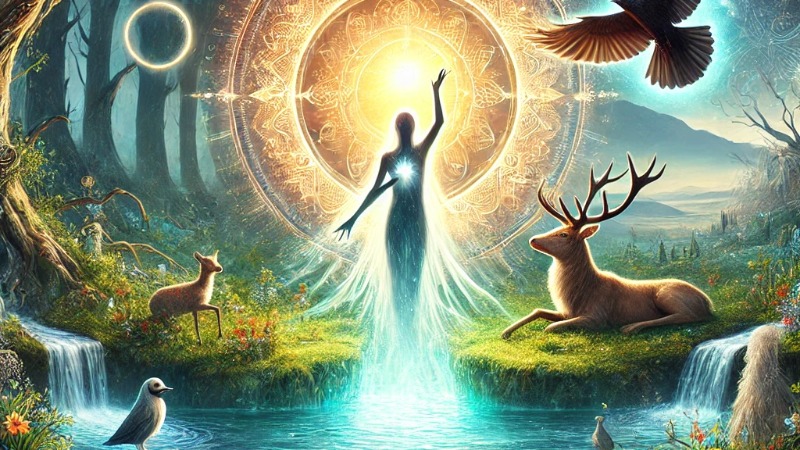In this post…
The term psychopomp may not be widely recognized, yet its significance is deeply rooted in spiritual traditions and mythologies across cultures. Derived from the Greek words “psyche” (soul) and “pompos” (guide), a psychopomp is essentially a guide for souls transitioning between the realms of the living and the dead. These spiritual entities, figures, or archetypes play a critical role in navigating the mysterious and often daunting journey of death, offering a sense of direction and peace to those departing the earthly plane.
What is a Psychopomp?
A psychopomp is a mediator between the world of the living and the afterlife. Unlike deities of death, psychopomps do not judge or determine the fate of souls. Instead, their role is to assist in the transition, ensuring that the soul reaches its proper destination.
These “soul conductors” appear in many forms throughout mythology and religion. For instance:
- Hermes in Greek mythology serves as a psychopomp, guiding souls to the underworld.
- Anubis, the ancient Egyptian god of mummification, escorts souls to their judgment.
- In Christianity, angels often help souls ascend to heaven.
- Indigenous cultures frequently feature animal soul conductors, such as ravens, wolves, or owls, as spiritual guides for the deceased.
These figures, whether human, divine, or animal, symbolize the universal human concern with understanding and preparing for death’s inevitability.
Role in Spiritual Practices
Psychopomps are not merely mythical or religious figures; they hold an active place in contemporary spiritual and shamanic practices. In many traditions, including shamanism, the role can be assumed by a practitioner who aids in guiding lost or stuck souls to the next phase of existence. This practice is often referred to as “soul rescue” or “spiritual psychopomp work.”
Shamans, functioning as intermediaries between the spiritual and physical worlds, often perform rituals to help the dead find peace. They can use tools such as drumming, chanting, or meditation to journey into spiritual realms and connect with the departed. This role is vital for both the souls of the deceased and the living, as unresolved energies can sometimes manifest as disturbances or imbalances in the physical world.
Shamanic Druidry
Shamanic Druidry is a spiritual path that weaves together the ancient traditions of Druidry and shamanism, both of which deeply honor the cycles of life and death. Within this framework, the concept of the soul conductor holds a special place, offering insights into how the living and the dead remain interconnected.
The Druidic Perspective
Druids, as spiritual leaders in ancient Celtic cultures, were deeply attuned to the rhythms of nature, the cycles of life, and the mysteries of death. They recognized death not as an end but as a transition to another state of being. Through their rituals, Druids sought to honor the dead and ensure a smooth passage to the afterlife.
The Druid’s connection with nature also aligns with the archetype of the soul guide. For example, animals such as crows and deer are often seen as messengers between worlds in Celtic mythology, symbolizing the guidance provided by psychopomps.
The Shamanic Aspect

Shamanic Druidry incorporates the shamanic practice of journeying, wherein practitioners enter altered states of consciousness to access spiritual realms. In these journeys, the practitioner can encounter figures who guide souls or act as one themselves, guiding souls who are lost or seeking closure.
One of the most profound aspects of shamanic Druidry is the understanding that death is a natural and sacred part of life. By embracing this perspective, practitioners can approach psychopomp work with compassion, reverence, and a deep sense of purpose.
Why They Matter Today
In modern times, the psychopomp archetype resonates with those seeking to understand the mysteries of death and what lies beyond. This role is particularly significant in:
- Grief and Healing: The idea of a soul being guided to peace can bring comfort to those grieving the loss of a loved one.
- Spiritual Growth: Exploring the concept of psychopomps can deepen one’s understanding of life, death, and the interconnectedness of all beings.
- End-of-Life Care: Some hospice workers and spiritual counselors draw upon the psychopomp’s role to provide compassionate support to the dying and their families.
By embracing the wisdom of psychopomps, we are reminded that death is not something to fear but a journey to be embraced with grace and understanding.
Final Thoughts
Psychopomps embody the timeless human quest to navigate the unknown realms of death and the afterlife. From ancient myths to modern spiritual practices, they serve as bridges between worlds, offering guidance, comfort, and hope.
For those exploring paths like shamanic Druidry, the psychopomp represents a profound connection to the cycles of nature and the spiritual realms. By learning from these guides, we can foster a deeper appreciation for life’s transitions and the eternal dance of light and shadow, life and death.
Whether through mythology, shamanic practice, or personal exploration, the psychopomp reminds us that even in the darkest moments of transition, we are never truly alone.
Share Your Thoughts about Psychopomps!
Have you had any experiences with psychopomps? Do you think you could be one? Share your thoughts in the comments below!
